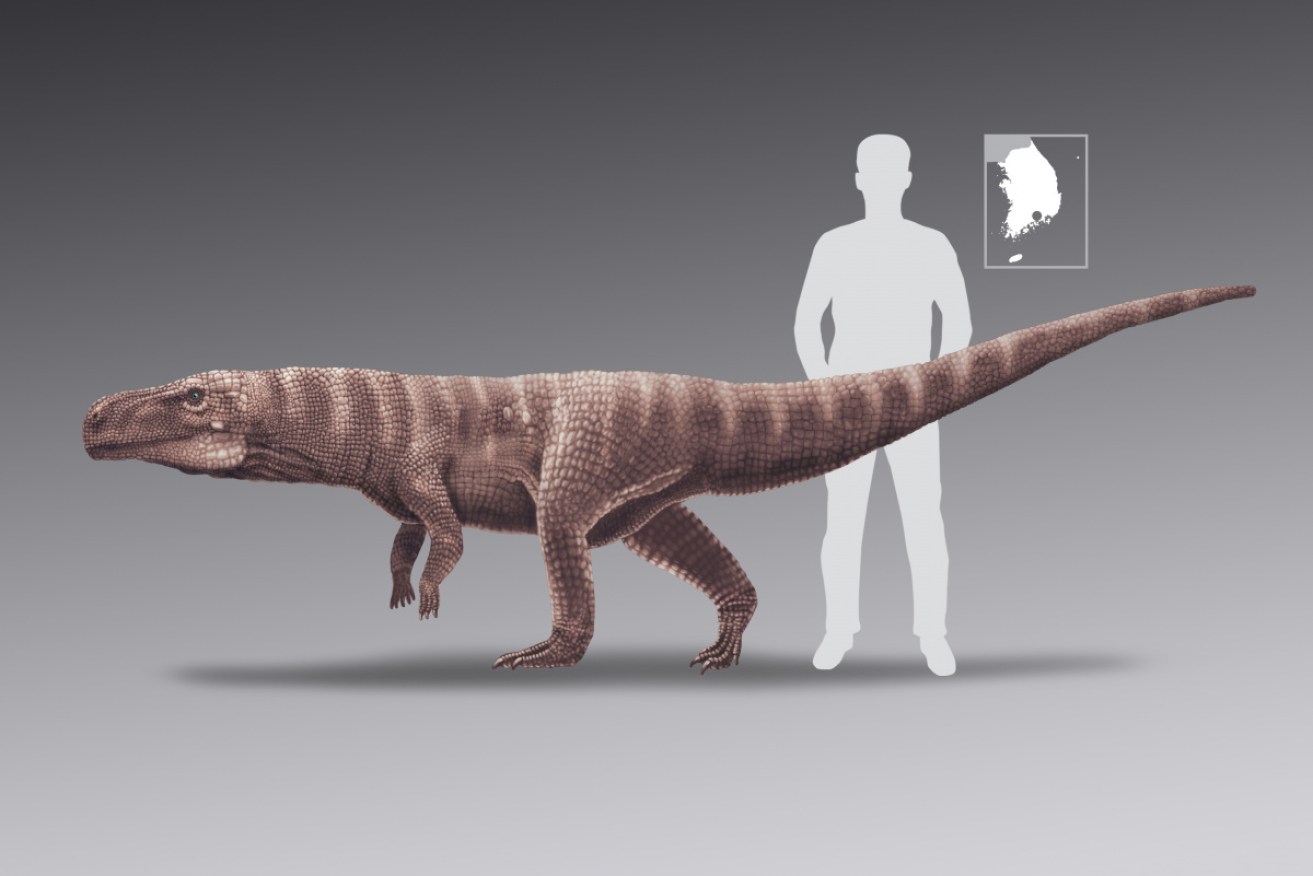A two-legged crocodile? Thankfully, they died out when the world was young


Without decent support from its front limbs, this early crocodile would have had serious back ache. Image: Anthony Romilio/UQ
Scientists have discovered footprints belonging to an ancient species of crocodile. But there’s a twist. These crocodiles – more than three metres long – effectively only had two feet, and walked about semi-upright like dinosaurs.
The international research team say the fossils are between 110 and 120 million years old. Found in South Korea, they’re said to be of “spectacular” quality.
But the researchers also use the words “weird” and “strange” to describe their findings.
Not a dinosaur, they don’t walk like that
Initially, the footprints were thought to have been made by a giant pterosaur – a flying reptile – walking on the mudflat.
The tracks indicated that the creature moved in a way seen in dinosaurs, their flying cousins and bird descendants. And there were no tail-drag marks that you find with modern crocodiles.
However, in a prepared statement, Professor Kyung Soo Kim from Chinju National University of Education, who led the research, said the team soon found clues as to why there were no hand prints.
“Typical crocodiles walk in a squat stance and create track-ways that are wide,” Professor Kim said.

Keeping their tails up these ancient crocodiles left no drag marks, almost fooling paleontologists. Image: Dr Anthony Romilio/UQ
“Oddly, our trackways are very narrow looking – more like a crocodile balancing on a tight-rope. When combined with the lack of any tail-drag marks, it became clear that these creatures were moving bipedally.”
Moved like dinosaurs, but more flat-footed
He said they were moving “in the same way as many dinosaurs, but the footprints were not made by dinosaurs.”

A single footprint made by an ancient South Korean bipedal crocodile. Photo: Dr Seul Mi Bae
Dinosaurs and their bird descendants walk on their toes. “Crocodiles walk on the flat of their feet, leaving clear heel impressions, like humans do,” Professor Kim said.
Dr Anthony Romilio is a research associate with University of Queensland’s Dinosaur Lab. He made the “track-maker reconstructions” – which means he created the images that give us an idea of what the creature probably looked like.
Dr Romilio said the footprints measured around 24 centimetres, suggesting the track-makers had legs about the same height as human adult legs.

Footprints left behind by the enigmatic and ancient South Korean bipedal crocodile, initially thought to be the tracks of a pterosaur. Photo: Dr Seul Mi Bae
“These were long animals that we estimate were over three metres in length,” he said, in a widely reported statement. “And while footprints were everywhere on the site, there were no hand prints.”
Dr Romilio said that, with fossils of creatures who got about on all fours, there is the potential for the hind feet to have stepped into the impression made by the hand and ‘over-printing’ it. But there was no evidence of this at the Korean sites.
He also noted that fossils were of such quality that they had preserved the fine details of the toe-pads and scales on their soles.
One of nature’s first attempts to make a crocodile
He told The New Daily: “These croc track-makers were not ancestors of modern crocodiles. We consider it as potentially an offshoot before modern crocodiles, or a long-lost relic from the Triassic.
“Either way, this is weird.”
He noted that bipedalism is inherently unstable, particularly for an animal built like crocodiles.
“Having the legs tucked under the body is a specialised way to control the ‘fall’, and when that control is obtained, then walking and running become much more efficient on land than the typical sprawling posture,” he said.
“We have proposed that these creatures were much more terrestrial adapted that many of its crocodile-peers … they definitely would have had a heavy load upon the hip region and required other specialisations along the vertebrae of the torso and tail to ensure stability, along with a likely chain of modifications to the load-bearing back legs.”








